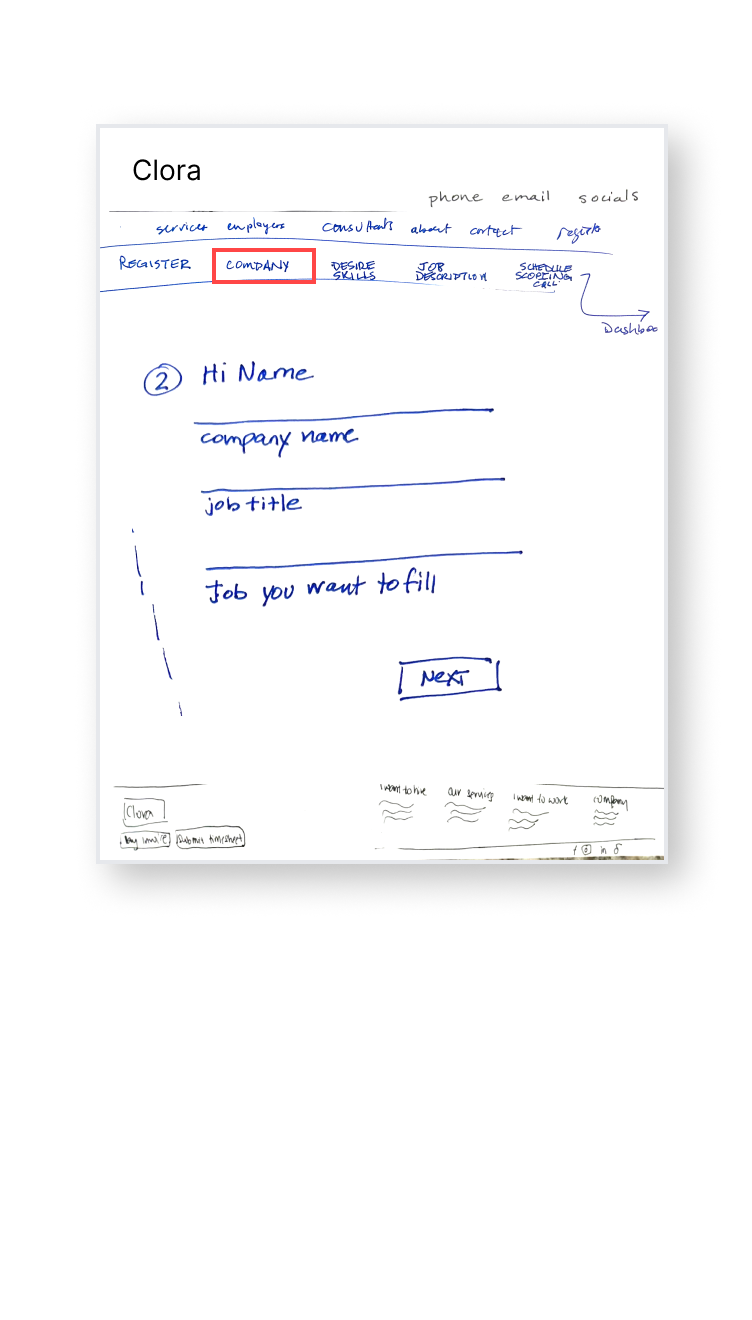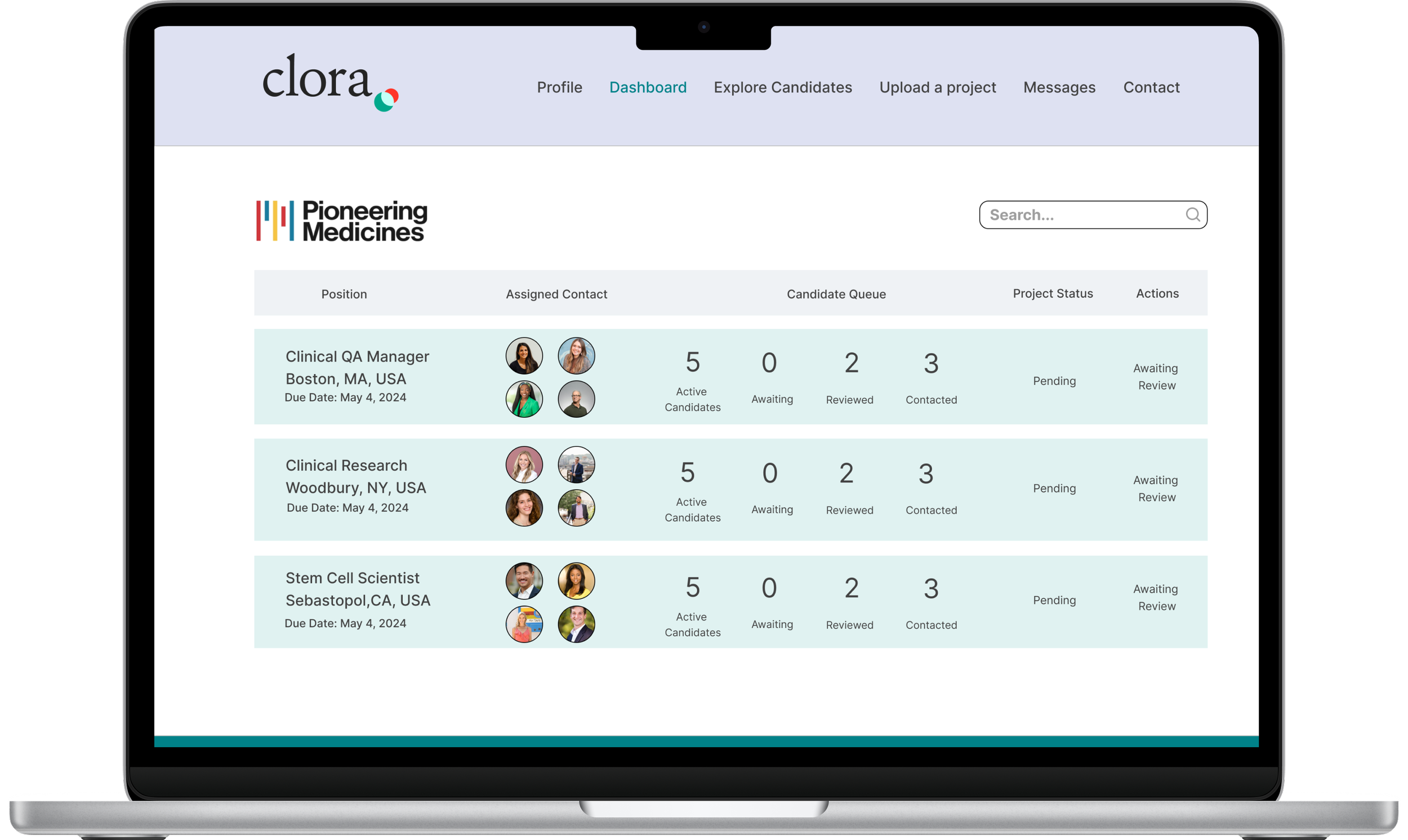
Clora
Role: UX Designer
Date: April - May 2024
Duration: Three-Week Sprint
Project: Increase customer engagement in the registration and onboarding process
What is Clora?
Some think Clora is a BioTech recruitment company but in reality, it is so much more. It aims to keep the biotech pipeline flowing by preventing disruptions caused by staffing needs. For BioTech Hiring Managers who build teams, Clora is a talent marketplace that delivers experts 10x faster and costs 70% less. Unlike traditional recruiters, Clora’s marketplace provides consultant recruiting, hiring, payroll and beyond. Its vast network of life science experts and algorithms identifies qualified candidates in days.
The Problem: how do you break a precedent?
As Clora is a seed-stage startup, it has yet to reach product market fit. To prove its concept, the operations team completes many registration and onboarding tasks on behalf of the clients which should be the client’s responsibility. A precedent has been set that Clora would like to change.
Clora presented us with the following challenge: increase employer engagement in the registration and onboarding workflow. Give autonomy back to the client from the first interaction with minimal friction.
I was curious about the word choice autonomy. Dictionary.com defines autonomy as independence or freedom, as of the will or one's actions. I pondered whether Clora customers lacked autonomy. I don’t think so. Clora customers exercise their autonomy by choosing not to complete the registration and onboarding tasks. They are accustomed to Clora doing it on their behalf. However, the challenge to overcome is to elicit customers to take responsibility for a fraction of the process. The faster customers own their part of the process, Clora can refocus its energy on growing the business.
User Interviews: Who are Clora’s customers?
Clora generously shared recent customer research with our team. We reviewed the video interviews and quickly discovered that the target customer could fall into two specific roles: Human Resources and Hiring Managers. Both had qualms with the other. Hiring managers wanted full control of who and how they hired. They believed HR slowed down the hiring process. HR had to adhere to company policy and legal requirements of the hiring process. HR could not have their colleagues going rogue. Interestingly, they both wanted the same thing: fast hiring. They just have different methods of accomplishing it.
We also conducted our own research by interviewing a biotech founder/Chief Scientific Officer, a human resources director and a hiring manager. These individuals shared new information that shed light on BioTech hiring practices. Our founder explained the financial constraints startups face when in the early days. His main hiring practice was to rely on his network. I wondered whether one’s network dwindle as people are promoted. Peers in their network most likely advance, leaving openings in the roles that need to be filled and need for a new way to procure talent.
Big Questions. Big Opportunity. The Affinity Map.
V.I.P.
Two themes came up repeatedly: time and trust. No one has time, their time is valuable, they are busy, and they are important people responsible for the important stuff. They want to maintain control of hiring because the company's future depends on it. Beyond time challenges, there were questions about what Clora was. These two challenges drove the development of our problem and solution statements and our persona.
Persona
Heuristic Analysis
-
Typeface Size
Most high-level managers, directors and executives are in their 40s. According to the American Optometric Association, many adults in their early to mid-40s start to have problems seeing clearly at close distances, especially on the computer. Clora’s website font size is tiny. Users' frustration related to their struggle to read the content will likely lead them to abandon the site.

-
Consultant Filter
Very busy hiring managers seek Clora's services to shortnen the hiring process. To see 4271 potential candidates meet job requirements would be stressful for these managers. This large number would require copious amounts of time to sort through. and lead to the perception that Clora will not reduce hiring time. We recommend removing this count and presenting only the five to ten vetted, qualified candidates.

-
Messaging
The website highlights the consultants instead of the customer’s experience with the consultant and Clora. We recommend changing the narrative to highlight customers first instead of the anonymous consultants.

-
Image Size
The impact of the imagery is lost due to the photo's tiny size. Customers cannot decipher the features or emotions of the people pictured. The narrative is lost as the details of the images cannot be fully recognized or understood. An opportunity to connect and build trust with the customer is lost.

-
Faces
The website has very few faces for users to connect with. The faces on the website are undiscernible due to their small size. We recommend that Clora share key team members’ bios and photos.

Sketches
Our design team chose to sketch separately and return to the table to deliberate afterward. Each member brought unique ideas which we literally cut and pasted into one design. From the research, we found that our users were incredibly busy people. They needed the account creation process to be quick but not so easy as to elicit distrust. We added a confirm account feature to build the legitimacy of the account creation. We streamlined required data collection to as few pages as possible and added a feature depicting the user’s status in the data collection process. We also addressed the issues found in our heuristical analysis. Text was enlarged, images were enlarged and messaging was changed.
Wireframes
The building of our wireframes was quick. We spend a good amount of time sketching, refining and resketching. We discovered that we did need additional pages. We designed a login page for users after an account was established. We also created a dashboard page that depicted established job listings.
Delivery: Prototype
We had some fun when naming the prototype characters. We used names of characters on the sitcom The Big Bang Theory. The show follows the lives of several Caltech physicists living across the hall from an attractive actress. In the testimonial section, Spiro Therapeutics SVP is named Leslie Winkle and the consultant she hired was named Dr. John Sturgis. On the candidates page, we used the show’s main characters names: Leonard, Penny, Amy, Howard, Bernadette and Sheldon.
Using Adobe’s contrast checker, we verified that Clora’s color scheme met assessability standards. We used Clora’s existing color scheme.
Reflections: Trust Building
You never know when life will throw you a curveball, but it’s all but guaranteed that each of us will face that pitch. My curveball came hurling toward me just before my UX intensive began. My incredibly healthy mom was given a lung cancer diagnosis. Pulmonologists, Oncologists and the Cardiothoracic Surgeon reiterated that if one were to be diagnosed with lung cancer, this was the best type. It was slow-growing, fully contained and required only surgery to cure her. There would be no further treatment recommended. All of this was very encouraging but still scary. My mom’s surgery took place two and a half weeks into the three-week design sprint. The surgery day was harder on me than I anticipated.
During the first two and a half weeks of the sprint, our Clora design team conducted deep user research, analysis and design. We were building the prototype when surgery day came about and to my dismay, I needed to take the day off. I had to rely on my team to complete the final prototype. I worried about letting them down and about adding to their workloads. However, I trusted their judgment, talent and abilities. I believed they’d create an incredible final product. I realigned my perspective on “my contribution”; it was already woven throughout the design. I let go of the FOMO and gratefully cheered on the team.
Control: an Illussion
I have always believed that I can control two things: my reaction and my choices. They take practice and experience throughout a lifetime. This practice is most fruitful in the challenging, disappointing moments. It is in perceived losses where we grow most. My FOMO around the Clora prototype was rooted in my desire to pull my weight and be a good team member. I was disappointed, sad and preoccupied with my mom’s surgery. However, by refocusing my attention on the client, my team and the UX process, I aimed to react with gratitude for my team and peace knowing the UX process accounts for life’s disruptions.
My mom’s surgery was a grueling eight hours. She has since spent three individual weeks in the Cardiac ICU for complications. However, she is cancer-free. She is a model for good reactions and choices. She walks everywhere and works out daily. Her doctors are impressed by her determination and commitment to healing at an astonishing rate. We are both proud of each other as we pushed through a challenging season and chose to keep growing and learning from all that life throws our way.
Clora 2.0?
Two issues persisted in my mind during the project. First, the customer trust challenge: We don’t trust what we don’t know especially when one’s professional reputation is on the line. Second, I wondered if the name “Clora” was part of the problem. Its definition is unknown. It is not suggestive of the company’s purpose or service. An episode of Lenny’s Podcast inspired me to investigate these issues further. Episode guest Arielle Jackson presented her framework and philosophy on branding, positioning and naming companies. Check out my next case study exploring Clora’s brand Identity (crisis), creating a positioning statement and examining whether its name is a problem.






























